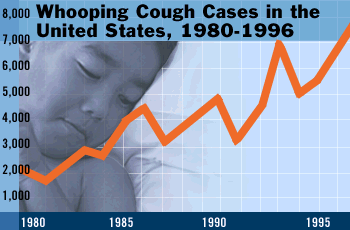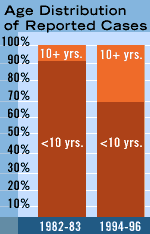
Reported cases of
whooping cough have been on the upswing in the United States since the early 1980s, and
researchers believe that many more cases go undiagnosed. (PhotoDisc/ABCNEWS.com) |
By Jenifer Joseph
ABCNEWS.com
March 10 — Pediatric nurse Susie Glenn and her teenage daughter were literally sick
to their stomachs with a terrible cough that persisted for three months.
They coughed so violently that they'd choke and vomit, a
situation that left them both exhausted. Doctors first diagnosed their ills as bronchitis,
then pneumonia. But none of the medications they prescribed for those ailments did much
good.
After three months of coughing hell, Glenn finally returned to
work, at the Kaiser Permanente Vaccine Study Center. The center's director, Dr. Henry
Shinefield, overheard one of her hacking fits and diagnosed it immediately: whooping
cough.
 The proportion of whooping cough cases in
people over age 10 has been gradually increasing . (ABCNEWS.com) The proportion of whooping cough cases in
people over age 10 has been gradually increasing . (ABCNEWS.com) |
Most people no longer worry about this bacterial
infection—also known as pertussis—a once-deadly childhood disease that was
virtually wiped out by vaccines. (Pertussis is the "p" in DPT shots.)
In the 1940s, 200,000 Americans, mostly children under 10 years
old, came down with whooping cough every year. By 1980, widespread vaccinations had pushed
the numbers down to about 1,000 cases.
But researchers at the infectious diseases conference now under
way in Atlanta are reporting an alarming trend: the re-emergence of this age-old disease.
As of 1996, some 7,800 U.S. cases were diagnosed, says Centers for Disease Control
epidemiologist Dr. Dalya Guris, and that's just the tip of the iceberg.
Mistaken Identity
In an effort to see just how common pertussis is, Guris and others have been studying
people with coughs lasting longer than two weeks. Their research shows that as many as 90
percent of all whooping cough illnesses go undetected. In other words, up to 500,000
Americans could have the infection right now, but think it's just a bad cold.
"This is an enormous incidence rate that's
unrecognized," says Kaiser Permanente's Shinefield, whose own study in 1996 had
similar results. "There are more cases now than there were in 1945, before we had the
vaccine."
Part of the problem is that whooping cough in adults isn't usually
accompanied by the characteristic "whoop" that you hear at the end of the cough
in children. The only symptom in teens and adults may be a cough that simply won't go
away.
Whooping cough is easily treated with antibiotics. But all too
often, doctors send patients home to wait out their "cold." That can pose a
serious danger to infants, who are hit hardest by whooping cough because of their fragile
immune systems.
Vaccine Wear and Tear
The reasons for the upswing in adult pertussis cases are unclear. It may be due in part to
the waning effectiveness of the vaccine as people grow older. Ninety-five percent of all
2-year-olds in the United States have been vaccinated against whooping cough.
But researchers think that, unlike vaccines for measles and mumps,
the pertussis immunizations may be effective for only seven years. And since booster shots
aren't approved for use in anyone older than 7, it's no wonder that adults may be more
susceptible to the disease.
That still doesn't fully explain why the numbers jumped so high,
so quickly. If weakening protection from vaccine were the main reason, researchers say,
such an upswing would have been evident decades ago.
The Food and Drug Administration so far has remained reluctant to
approve an adult booster until more research is done.
So for now, Guris says, it falls on the doctors' shoulders to look
more carefully at patients with long-lasting coughs.
![]()

 The proportion of whooping cough cases in
people over age 10 has been gradually increasing . (ABCNEWS.com)
The proportion of whooping cough cases in
people over age 10 has been gradually increasing . (ABCNEWS.com)